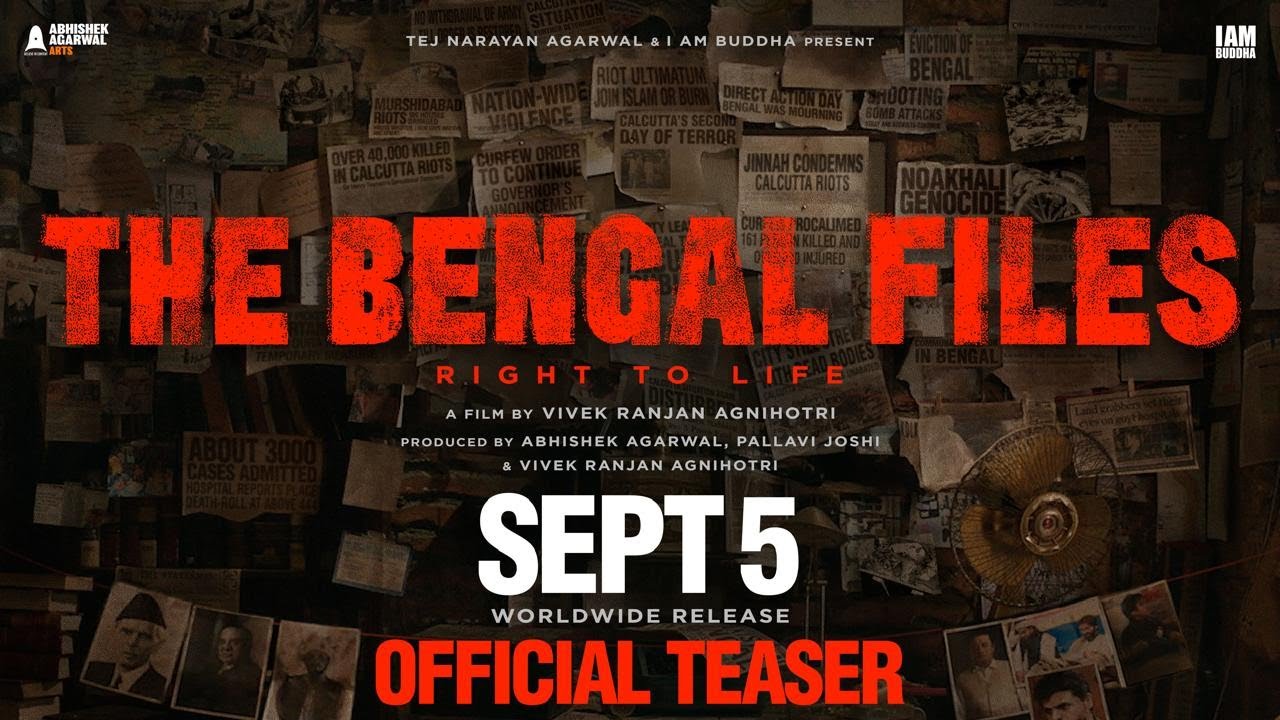The Bengal Files (2025) Movie Review
Unraveling History Through the Lens of Bold Cinema
The Bengal Files (2025) emerges as a searing historical drama.
Vivek Ranjan Agnihotri takes audiences deep into a dark chapter of Indian history.
Director’s Vision and Artistic Signature
Agnihotri’s direction in this film is bold and unapologetic.
He captures trauma through raw imagery and a haunting narrative style.
The realism in his storytelling avoids melodrama.
Instead, he employs a near-documentary approach, reminiscent of his previous “Files” films.
Directorial Choices That Define the Narrative
The film’s gritty palette and jarring cuts intensify viewer discomfort.
Key scenes avoid background score, allowing silence to amplify impact.
Agnihotri refrains from theatrical dialogues, focusing on expressive visuals.
His choice to keep the camera lingering on still bodies adds to the realism.
Influences and Inspirations
The Bengal Files draws inspiration from real-life events like the Noakhali riots.
Stylistically, it channels cinema-verité aesthetics from global political dramas.
There’s a noticeable influence of early Govind Nihalani in the tonal sharpness.
The film also borrows pacing elements from The Kashmir Files, but on a broader scale.
Cast Performance & Character Evolution
Mithun Chakraborty plays a weathered soul burdened by memory.
His transformation across the narrative shows a deep inner erosion.
Anupam Kher brings a voice of reason and empathy.
His character arcs from passive observer to emotional catalyst.
Darshan Kumaar once again portrays the pain of loss with honest vulnerability.
His portrayal anchors the film’s emotional highs and lows.
Pallavi Joshi and Puneet Issar bring layers to their supporting roles.
They embody ideologies and fears of the era they represent.
Screenplay and Dialogue Quality
The screenplay is sharp, calculated, and structured with heavy metaphors.
Dialogues are minimal, relying more on action and silence.
This restraint adds gravitas to the film’s narrative.
Expository scenes are replaced with visual symbolism.
Genre Context and Comparison
As a political thriller and historical drama, The Bengal Files outpaces many recent releases.
It avoids gloss, instead emphasizing authenticity and discomfort.
Compared to mainstream historicals, this film lacks romanticism and chooses grit.
It stands closer to films like Haider or Parzania than to commercial period dramas.
Cinematic Craft and Visuals
Sepia-toned frames dominate, lending an archival authenticity.
Slow-motion shots are used not for flair but to pause on pain.
Blood, silence, and eyes filled with fear linger long after scenes end.
There is little relief; the camera confronts viewers rather than entertains.
Box Office Expectations and Cultural Ripples
Following the trajectory of Agnihotri’s earlier works, The Bengal Files is expected to be a blockbuster.
It’s already generating conversations for its bold themes.
Controversy may propel ticket sales, as seen previously.
The film might become a focal point for socio-political debates nationwide.
Performance Table
| Actor | Role Impact | Performance Highlight |
|---|---|---|
| Mithun Chakraborty | High | Recites the Preamble with emotional gravity |
| Anupam Kher | Strong | Empathic mentor figure |
| Darshan Kumaar | Emotional | Channels deep inner trauma |
| Pallavi Joshi | Layered | Conveys ideological weight |
Star Rating
| Category | Rating |
|---|---|
| Direction | ★★★★☆ |
| Storyline | ★★★★☆ |
| Performances | ★★★★☆ |
| Visual Style | ★★★★☆ |
| Overall Impact | ★★★★☆ |
Disclaimer: The rating may vary based on final release and individual perspectives.
FAQs
Question 1
What is The Bengal Files based on?
Answer 1
It is based on the communal violence in Bengal during the 1940s, especially the Direct Action Day and Noakhali riots.
Question 2
Who directed The Bengal Files?
Answer 2
Vivek Ranjan Agnihotri directed the film, continuing his historical-political trilogy.
Question 3
What is the film’s central theme?
Answer 3
It focuses on forgotten genocides and historical silence around Hindu persecution.
Question 4
How is the film different from The Kashmir Files?
Answer 4
While similar in tone, The Bengal Files covers an earlier era with a wider geographical and emotional scale.
Question 5
Is the film suitable for all audiences?
Answer 5
The graphic content may not be suitable for sensitive viewers or younger audiences.
Final Verdict
The Bengal Files is not merely a film—it’s a cinematic outcry.
A raw, uncomfortable mirror reflecting the neglected fragments of history.
It dares to tell what others won’t, challenging viewers to look closer.
For those seeking truth wrapped in strong storytelling, it is a necessary watch.



